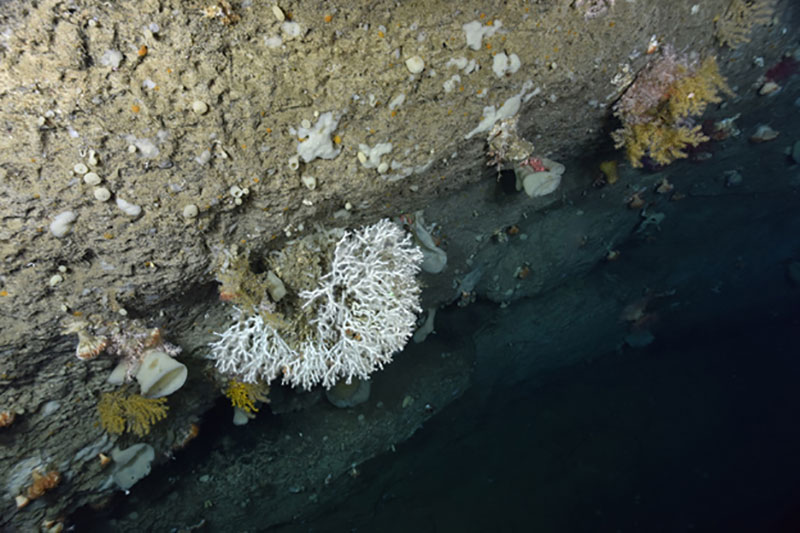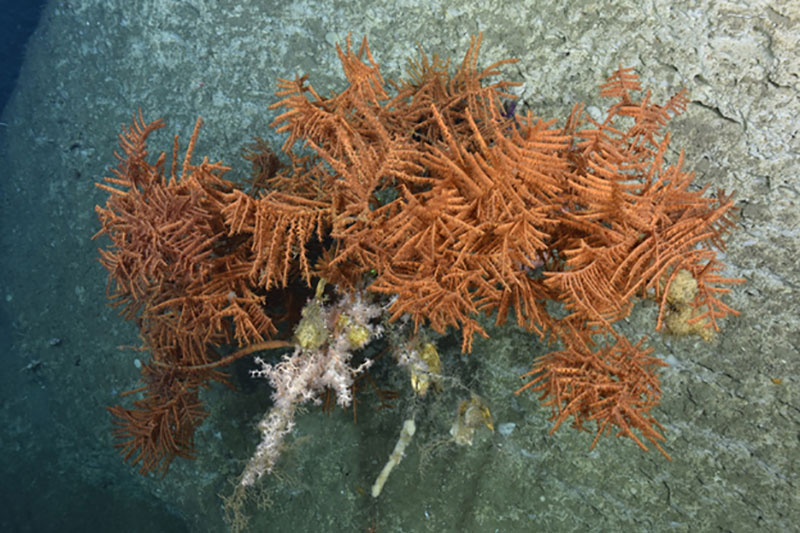
by Dave Packer, NOAA Marine Ecologist
June 11, 2017

The colonial stony coral Lophelia pertusa (white) with Paramuricea (yellow), along with sponges and stony cup corals (both white) on a vertical wall in an unnamed “minor” canyon between Munson and Nygren Canyons. Image courtesy of Northern Neighbors: Transboundary Exploration of Deepwater Communities. Download image (jpg, 247 KB).
Chief Scientists’ weather report: bright and sunny, with calming seas, with a rising feeling of anticipation and excitement.
The remnants of the storm were still recognizable in the swells that we either endured or enjoyed as we slept overnight. We arrived at our first station, an area on the continental slope between Munson and Nygren canyons that contained many smaller, unnamed canyons. We were on stand-by mode as we waited for the sea state to further improve before launching. Short delays are part of the routine at sea, but it’s always better to wait and make sure both humans and equipment are safe and ready to go.
Finally, all the practice and preparation paid off as the remotely operated vehicle (ROV) was successfully launched at around 10:00 am. It took more than an hour for the ROPOS to make its slow descent to its first “way point” at 950 meters at the bottom of an unnamed canyon. All the scientists were huddled together around the many screens of the ROPOS command center as the first pictures of the bottom came in. Mud!! Glorious mud! Pulling out a sediment “push corer,” the ROPOS immediately took a sediment core sample for Dr. Paul Snelgrove and his student Marta Miatta. And then...the main forward camera went dark. The ROPOS crew tried to fix the problem remotely, but eventually had to bring the ROV back up to the ship.

ROPOS collecting a glass sponge and storing it in a “biobox.” Image courtesy of Northern Neighbors: Transboundary Exploration of Deepwater Communities. Download image (jpg, 201 KB).
Once on deck, the ROPOS crew swarmed over the vehicle and and repaired the camera problem. ROPOS was relaunched at 4:30 pm for a short, but spectacular, dive.
We moved up one steep canyon wall from 973 – 813 meters depth, passing ledges and overhangs and terraces. We saw many abundant and diverse species of corals in a rainbow of colors, including: the white colonial stony coral Lophelia pertusa and the orange colonial stony coral Solenosmilia, the solitary cup coral Desmophyllum (also a stony coral), the yellow sea fan Paramuricea, the true soft corals like the red Anthomastus and the purple Clavularia, black corals such as Parantipathes, and many more.

Unidentified black coral and white Anthothela (?) on a vertical wall in an unnamed “minor” canyon between Munson and Nygren Canyons. Image courtesy of Northern Neighbors: Transboundary Exploration of Deepwater Communities. Download image (jpg, 318 KB).
Lophelia in particular excited the scientists because this was the most we’ve seen anywhere in these northern canyons, and the ROPOS collected some specimens for genetic studies by Dr. Cheryl Morrison. We collected several other species of deep-sea corals and sponges as well, some for identification purposes. As many of these organisms are not easy to identify or distinguish from one another visually, we need to collect them for identification by professional deep-sea coral and sponge taxonomists.
This was such a great dive that we decided to stay here and explore more of this canyon tomorrow. So, it was definitely worth the wait – but now we can’t wait till the next dive!